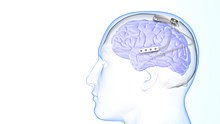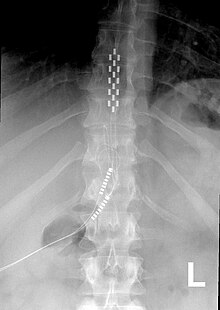Responsive neurostimulation device

Responsive neurostimulation device is a medical device that senses changes in a person's body and uses neurostimulation to respond in the treatment of disease. The FDA has approved devices for use in the United States in the treatment of epileptic seizures[1] and chronic pain[2] conditions. Devices are being studied for use in the treatment of essential tremor,[3] Parkinson's disease,[4] Tourette's syndrome,[5] depression,[6] obesity,[7] and post-traumatic stress disorder.[8]
Medical uses
[edit]Epilepsy
[edit]The use of neurostimulation to treat epileptic seizures is only recommended in those who have failed multiple medications for the treatment of their seizures. The NeuroPace RNS system was approved for use by the FDA in 2013 and is the only medical device for epilepsy that uses responsive neurostimulation.[1] The device is surgically implanted into the patient's head with electrical leads placed near the site in the brain that is believed to be the origin of the patient's seizures. These leads record electrical activity in the brain and deliver electrical stimulation when a seizure is detected.[9] The device keeps a record of abnormal electrical activity that is reviewed by a neurologist to improve the detection and treatment of seizures. The patient is able to record when they are having symptoms with the device to see if their symptoms are correlating with seizures.[1] The use of responsive stimulation has found to be effective for seizure reduction. Some patients are able to achieve complete seizure freedom with responsive and non-responsive neurostimulation.[10]
Chronic pain
[edit]
Neurostimulation for chronic pain is primarily through the use of spinal cord stimulators.[11] These devices deliver electrical stimulation to different areas of the spine based on where they are implanted. Since 2012, Medtronic has produced spinal cord stimulators with accelerometers that can predict the patient's position. The device can be programmed to give additional electrical stimulation if the patient is thought to be in a more painful position.[12]
Research
[edit]Reponsive neurostimulation is an active area of research with multiple clinical trials underway. Continuous, or non-responsive, neurostimulation has been FDA approved since 2002 with the introduction of deep brain stimulators for Parkinson's disease.[13] As medical technology has improved, so has our understanding of neural networks and their role in human disease. Adding sensing capabilities to these devices has provided new targets to stimulate and feedback into how to more effectively stimulate the brain.[14] At this time, there are clinical trials for reponsive neurostimulation devices in the treatment of essential tremor,[3] Parkinson's disease,[4] Tourette's syndrome,[5] depression,[6] obesity,[7] and post-traumatic stress disorder.
See also
[edit]References
[edit]- ^ a b c Geller, Eric B. (2018-11-01). "Responsive neurostimulation: Review of clinical trials and insights into focal epilepsy". Epilepsy & Behavior. 88: 11–20. doi:10.1016/j.yebeh.2018.06.042. ISSN 1525-5050. PMID 30243756. S2CID 52341485.
- ^ Kim, Eun kyoung; Lee, Chang-soon; Yoo, Yongjae; Park, Jin-Woo; Kim, Jung Soo; Kim, Youngwon; Moon, Jee Youn; Kim, Yong-Chul (2020-03-13). "The Long-term Effectiveness of the Automatic Position-Adaptive System in Spinal Cord Stimulation: A Retrospective Comparative Study with a Two-Year Follow-up". Pain Medicine. 21 (10): 2288–2297. doi:10.1093/pm/pnaa121. ISSN 1526-2375. PMID 32443142.
- ^ a b Castaño-Candamil, Sebastián; Ferleger, Benjamin I.; Haddock, Andrew; Cooper, Sarah S.; Herron, Jeffrey; Ko, Andrew; Chizeck, Howard J.; Tangermann, Michael (2020). "A Pilot Study on Data-Driven Adaptive Deep Brain Stimulation in Chronically Implanted Essential Tremor Patients". Frontiers in Human Neuroscience. 14: 541625. doi:10.3389/fnhum.2020.541625. ISSN 1662-5161. PMC 7674800. PMID 33250727.
- ^ a b Arlotti, Mattia; Colombo, Matteo; Bonfanti, Andrea; Mandat, Tomasz; Lanotte, Michele Maria; Pirola, Elena; Borellini, Linda; Rampini, Paolo; Eleopra, Roberto; Rinaldo, Sara; Romito, Luigi; Janssen, Marcus L. F.; Priori, Alberto; Marceglia, Sara (2021-12-07). "A New Implantable Closed-Loop Clinical Neural Interface: First Application in Parkinson's Disease". Frontiers in Neuroscience. 15: 763235. doi:10.3389/fnins.2021.763235. ISSN 1662-4548. PMC 8689059. PMID 34949982.
- ^ a b Molina, Rene; Okun, Michael S.; Shute, Jonathan B.; Opri, Enrico; Rossi, P. Justin; Martinez-Ramirez, Daniel; Foote, Kelly D.; Gunduz, Aysegul (2017-09-17). "Report of a patient undergoing chronic responsive deep brain stimulation for Tourette syndrome: proof of concept". Journal of Neurosurgery. 129 (2): 308–314. doi:10.3171/2017.6.JNS17626. ISSN 0022-3085. PMC 7007215. PMID 28960154.
- ^ a b Scangos, Katherine W.; Makhoul, Ghassan S.; Sugrue, Leo P.; Chang, Edward F.; Krystal, Andrew D. (2021-01-18). "State-dependent responses to intracranial brain stimulation in a patient with depression". Nature Medicine. 27 (2): 229–231. doi:10.1038/s41591-020-01175-8. ISSN 1546-170X. PMC 8284979. PMID 33462446.
- ^ a b Formolo, Douglas A.; Gaspar, Joana M.; Melo, Hiago M.; Eichwald, Tuany; Zepeda, Ramiro Javier; Latini, Alexandra; Okun, Michael S.; Walz, Roger (2019). "Deep Brain Stimulation for Obesity: A Review and Future Directions". Frontiers in Neuroscience. 13: 323. doi:10.3389/fnins.2019.00323. ISSN 1662-453X. PMC 6482165. PMID 31057350.
- ^ Bina, Robert W.; Langevin, Jean-Phillipe (2018). "Closed Loop Deep Brain Stimulation for PTSD, Addiction, and Disorders of Affective Facial Interpretation: Review and Discussion of Potential Biomarkers and Stimulation Paradigms". Frontiers in Neuroscience. 12: 300. doi:10.3389/fnins.2018.00300. ISSN 1662-453X. PMC 5945819. PMID 29780303.
- ^ Nair, Dileep R.; Laxer, Kenneth D.; Weber, Peter B.; Murro, Anthony M.; Park, Yong D.; Barkley, Gregory L.; Smith, Brien J.; Gwinn, Ryder P.; Doherty, Michael J.; Noe, Katherine H.; Zimmerman, Richard S.; Bergey, Gregory K.; Anderson, William S.; Heck, Christianne; Liu, Charles Y. (2020-09-01). "Nine-year prospective efficacy and safety of brain-responsive neurostimulation for focal epilepsy". Neurology. 95 (9): e1244 – e1256. doi:10.1212/WNL.0000000000010154. ISSN 0028-3878. PMC 7538230. PMID 32690786.
- ^ Touma, Lahoud; Dansereau, Bénédicte; Chan, Alvin Y.; Jetté, Nathalie; Kwon, Churl-Su; Braun, Kees P. J.; Friedman, Daniel; Jehi, Lara; Rolston, John D.; Vadera, Sumeet; Wong-Kisiel, Lily C.; Englot, Dario J.; Keezer, Mark R. (2022-03-22). "Neurostimulation in people with drug-resistant epilepsy: Systematic review and meta-analysis from the ILAE Surgical Therapies Commission". Epilepsia. 63 (6): 1314–1329. doi:10.1111/epi.17243. ISSN 0013-9580. PMID 35352349. S2CID 247792263.
- ^ Knotkova, Helena; Hamani, Clement; Sivanesan, Eellan; Le Beuffe, María Francisca Elgueta; Moon, Jee Youn; Cohen, Steven P; Huntoon, Marc A (2021-05-29). "Neuromodulation for chronic pain". The Lancet. 397 (10289): 2111–2124. doi:10.1016/S0140-6736(21)00794-7. PMID 34062145. S2CID 235245558.
- ^ Schultz, David M.; Webster, Lynn; Kosek, Peter; Dar, Urfan; Tan, Ye; Sun, Mark (January 2012). "Sensor-driven position-adaptive spinal cord stimulation for chronic pain". Pain Physician. 15 (1): 1–12. doi:10.36076/ppj.2012/15/1. ISSN 2150-1149. PMID 22270733.
- ^ Gardner, John (2013-05-13). "A history of deep brain stimulation: Technological innovation and the role of clinical assessment tools". Social Studies of Science. 43 (5): 707–728. doi:10.1177/0306312713483678. ISSN 0306-3127. PMC 3785222.
- ^ Denison, Tim; Morrell, Martha J. (2022-01-11). "Neuromodulation in 2035: The Neurology Future Forecasting Series". Neurology. 98 (2): 65–72. doi:10.1212/WNL.0000000000013061. ISSN 0028-3878. PMC 8762584. PMID 35263267.
